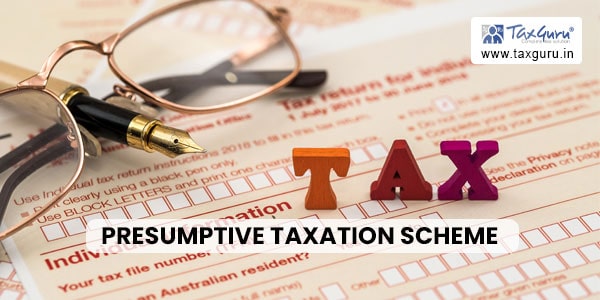“Explore Section 44AD and Section 44ADA of the Income Tax Act, offering presumptive taxation schemes for businesses and professionals. Learn eligibility, calculation methods, deductions, filing requirements, and examples. Make informed decisions with insights into these tax provisions. Case study included. Consult a tax professional for personalized guidance.”
Let’s delve into Section 44AD and Section 44ADA of the Income Tax Act, their provisions, and their implications for taxpayers, along with relevant examples and a case study
Section 44AD of the Income Tax Act: Section 44AD provides a presumptive taxation scheme for eligible businesses. It allows certain eligible taxpayers to calculate their taxable income based on a prescribed percentage of their total turnover. Here are the key features of Section 44AD:
1. Eligibility Criteria:
a. Applicability: Section 44AD is applicable to resident individuals, Hindu Undivided Families (HUFs), and partnerships (excluding Limited Liability Partnerships) engaged in specific businesses, except those earning income from specified professions.
b. Turnover Limit: The total turnover or gross receipts of the eligible business should not exceed Rs. 2 crores in the financial year.
2. Presumptive Taxation:
Under Section 44AD, eligible taxpayers are not required to maintain regular books of accounts. Instead, they can calculate their taxable income at a prescribed percentage of their total turnover. The prescribed percentage varies depending on the nature of the business:
a. Non-cash Transactions: If the business receives payments through non-cash modes, such as digital transactions or banking channels, the presumptive tax rate is 6% of total turnover.
b. Cash Transactions: If the business receives a substantial portion of its receipts in cash, the presumptive tax rate is 8% of total turnover.
3. Deductions and Expenses: Taxpayers opting for Section 44AD are deemed to have claimed deductions for various expenses. As a result, they cannot claim any additional deductions under other provisions of the Income Tax Act. However, deductions related to Section 30 to Section 38 (expenses directly related to business) are allowed.
4. Filing of Tax Returns: Taxpayers opting for Section 44AD must file their income tax returns (ITR) in Form ITR-4. They are not required to maintain regular books of accounts or get them audited under Section 44AB.

Example: Suppose Mr. A is a small retailer with a turnover of Rs. 1.5 crores in the financial year. He opts for the presumptive taxation scheme under Section 44AD. As per the prescribed rate of 6% for non-cash transactions, his taxable income will be Rs. 9 lakhs (6% of Rs. 1.5 crores).
Section 44ADA of the Income Tax Act: Section 44ADA provides a similar presumptive taxation scheme but specifically for professionals. It allows eligible professionals to calculate their taxable income based on a prescribed percentage of their total gross receipts. Here are the key features of Section 44ADA:
1. Eligibility Criteria: a. Applicability: Section 44ADA is applicable to resident individuals and HUFs engaged in specified professions such as legal, medical, engineering, architectural, accounting, technical consultancy, interior decoration, etc.
b. Gross Receipts Limit: The total gross receipts of the professional should not exceed Rs. 50 lakhs in the financial year.
2. Presumptive Taxation: Similar to Section 44AD, professionals covered under Section 44ADA are not required to maintain regular books of accounts. They can calculate their taxable income at a prescribed percentage of their total gross receipts. The prescribed rate is 50% of total gross receipts.
3. Deductions and Expenses: Professionals opting for Section 44ADA are deemed to have claimed deductions for various expenses. They cannot claim any additional deductions under other provisions of the Income Tax Act, except for deductions under Section 80CCD (1) and Section 80CCD (2).
4. Filing of Tax Returns: Professionals opting for Section 44ADA must file their income tax returns (ITR) in Form ITR-4. They are not required to maintain regular books of accounts or get them audited under Section 44AB.
Example: Suppose Dr. B is a medical practitioner with gross receipts of Rs. 40 lakhs in the financial year. He opts for the presumptive taxation scheme under Section 44ADA. As per the prescribed rate of 50%, his taxable income will be Rs. 20 lakhs (50% of Rs. 40 lakhs).
Case Study: Let’s consider the case of Mr. C, a resident individual running a small business as a contractor. His total turnover for the financial year is Rs. 1.8 crores, and he opts for the presumptive taxation scheme under Section 44AD. As per the prescribed rate of 8% for cash transactions, his taxable income will be Rs. 14.4 lakhs (8% of Rs. 1.8 crores).
In this case, Mr. C is not required to maintain regular books of accounts or get them audited. He can file his income tax return (ITR) in Form ITR-4 and pay taxes based on the presumptive taxation scheme.
It’s important to note that while the presumptive taxation scheme under Section 44AD and Section 44ADA simplifies the tax calculation process for eligible taxpayers, they may not be suitable for all businesses and professionals. It’s advisable to consult a tax professional or chartered accountant to evaluate the most appropriate tax scheme based on individual circumstances.
****
Author is A Practicing Chartered Accountant with over 5 years of rich experience in Company Law, Audits, Accounts & taxation. She is keen in streamlining business accounts of the Company and provide Startup consultancy. She can be connected on sweta@caswetamakwana.com






I understand if the business income is below 2 Cr and major transactions are digital/online taxable business income is 6% and any other income like interes or rent may be added to this to find nett taxable income. For professionals 50% of income if that’s below 50 lakhs p.a and any other kind of income like salary , rent added to that makes the total taxable income. I don’t know att what stage deductions order 80c are made I am medical person and not tax professional
It is not correct to suggest that taxable income is only 6% – it appears to be misleading- the reason is that AOs have pulled up taxpayers & accused them of tax evasion – it is important that actual profit is added to other income and income tax is then computed- the only two advantages we can think of presumptive taxation are: no audit; total tax for the profit can be paid on 15th march – no advance tax schedules
It is not correct to suggest that taxable income is only 6% – it appears to be misleading- the reason is that AOs have pulled up taxpayers & accused them of tax evasion – it is important that actual profit is added to other income and income tax is then computed- the only two advantages we can think of presumptive taxation are: no audit; total tax for the profit can be paid on 15th march – no advance tax schedules – would be thankful to revert back if i am wrong